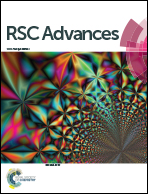Light-modulated aggregation behavior of some unsubstituted cinnamate-based ionic liquids in aqueous solutions†
Abstract
Light modulation of the self-assembly behavior of ionic liquids in aqueous solution is of great importance from the viewpoint of fundamentals and technology. In this work, a new class of light-responsive ionic liquids composed of 1-alkyl-3-methylimidazolium cations, [Cnmim]+ (n = 4, 6, 8, 10, 12), and the trans-cinnamic acid ([CA]) anion was synthesized and characterized. These compounds were used to study the modulation action of UV light on the aggregation behavior of ionic liquids in aqueous solution. For this purpose, the critical aggregation concentration (CAC), ionization degree of the aggregates (α), standard Gibbs energy of aggregation (ΔG°m) and aggregate size of the ionic liquids were determined before and after UV light irradiation by conductivity and dynamic light scattering techniques. The percentage of cis-isomer of these ionic liquids was also reported at the photoisomerism equilibrium from HPLC measurements. It was found that the aggregation behavior of [Cnmim][CA] (n = 8, 10, 12) could be efficiently modulated by UV light in aqueous solution. After UV light irradiation, the values of CAC, α and ΔG°m increased, while the size of the aggregates decreased. These results have been rationalized from the photo-isomerization of the [CA] anion, hydrophilicity and structural features of the cis-isomer of the [CA] anion.


 Please wait while we load your content...
Please wait while we load your content...